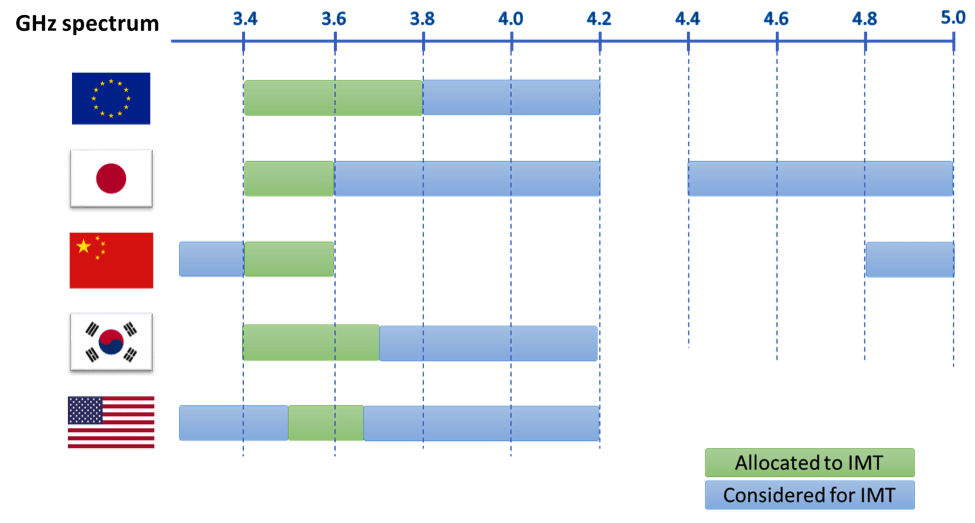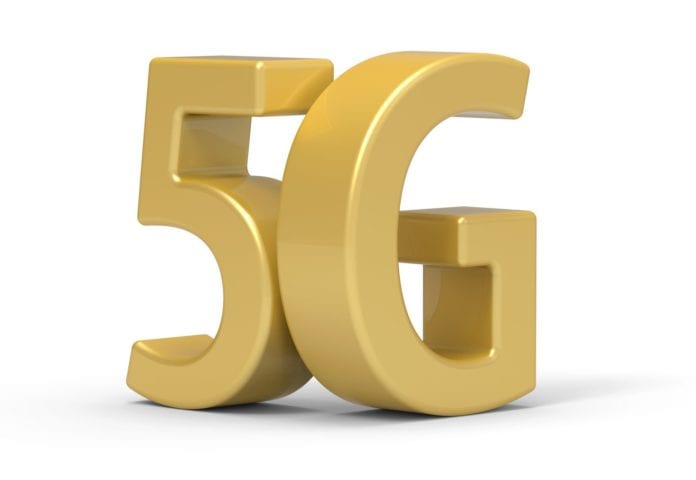Cellular network performance is driven by top speeds and overall system capacity, and more is
always better. Telcos have three main ways to increase these network parameters, both of which are so
vital for their business:
1. Deploy more spectrum through larger channels or using carrier aggregation to bring
spectrum together.
2. Improve spectral efficiency using new protocols, waveforms, and technologies,
including advanced modulation and coding schemes and higher-order MIMO.
3. Densify their networks by splitting existing cells or introducing small cells.
Although all three options enhance the performance of the system, there are pitfalls with the two
latter: protocol and technology improvements have already pushed the performance of current
cellular systems very close to the theoretical limit of the Shannon Theorem, while network
densification is usually a very expensive process, during which the distributed nature of the
deployment propels investment costs exponentially compared with typical macro cell
deployments. This leaves one viable option for telcos that has been exercised since the
deployment of 3G networks: acquire more spectrum at frequencies where wider channels can
be implemented.
Spectrum is king, but for different reasons for each G
Thus far, the success of any cellular technology launch has been tightly driven by the telco’s
spectral acquisitions. For example, the success of early 3G deployments was driven by the
amount of spectrum each telco had acquired in the 2 GHz band. The overall performance was
dependent on these allocations of spectrum. The initial performance and speed of these early
networks was low, hence requiring large amounts of spectrum. Nevertheless, early 3G systems
exposed end users to the availability of mobile data and early smartphones seeded the mobile
market for better implementations of mobile broadband standards. Enhancements of the
WCDMA standard, namely HSDPA and HSPA+, improved the performance of the network with
additional features, including technology enhancements, as well as support for more spectrum.
The case of 4G spectrum was quite different: it was U.S. telcos that accelerated the LTE market
with nationwide 700 MHz deployments and the first smartphones that supported the new
standard. Of course, 4G LTE did offer a leap in network performance and support for larger
spectrum blocks by introducing support for 10 MHz and 20 MHz channel bandwidths and the
possibility of carrier aggregation, which allowed operators to combine their 3G and 4G spectrum
in different bands to build blocks even larger than 20 MHz. This innovation accelerated the
global mobile broadband market. U.S. telcos—and the rest of the world—then proceeded with
further spectral acquisitions and repurposing of existing spectrum to augment and densify the
initial, basic coverage-driven deployments, because the consistent availability of megabit
throughput to end users created exponential demand from consumers and enterprises alike.
The examples outlined above indicate that a successful spectrum strategy depends on many
factors, the most important of which is market conditions. Larger amounts of spectrum are not
always a panacea, as a certain level of coverage needs to be met before a service can reach
the mass market. There are huge amounts of spectrum in higher frequencies, i.e., in mmWave
and sub-mmWave bands, but it is also prohibitively costly to deploy stand-alone wide coverage
in higher bands. ABI Research estimates that doubling the frequency of a cellular network
increases deployment costs by 5X to 10X, depending on the exact frequency and blanket
coverage across a city, state, or nation, and therefore, may not even be possible when the
carrier frequency exceeds a few GHz.
A similar spectrum trend will only continue with 5G, and the question is: how do 5G use cases
map with the spectral bands discussed today for the new standard?
5G spectrum: Are use cases matching spectral bands?
There are three key use cases for 5G currently: massive Machine Type Communications
(mMTC), Ultra Reliable and Low Latency Communications (URLLC) and enhanced Mobile
Broadband (eMBB). These three use cases address different types of applications and each
has different requirements, including in terms of spectrum, as illustrated in the following
diagram. 5G spectrum discussions today focus mostly on sub-6 GHz and mmWave spectrum in the
24 GHz to 29.5 GHz and the 37 GHz to 43.5 GHz spectrum ranges, with some other bands as
high as 86 GHz also under consideration in ITU-R in preparation for WRC-19.
The mMTC use case will likely require wide coverage, low data rates, and very large numbers of
connected devices. This translates to low frequencies, to achieve a large footprint at a low cost.
Existing Low Power WAN (LPWAN) systems that are being deployed today, including LTE-M
and NB-IoT, will likely converge under the 5G umbrella.
The URLLC use case is not tied to specific spectrum bands or coverage conditions, but does
require low latency and tightly integrated network design for critical communication use cases. It
may not depend on a specific spectrum range, because it may be deployed in a wide coverage
area (e.g., public safety) or on a single factory floor for industrial control. The availability of
chipsets and devices is likely to define this market, as well as the specific use cases developed
for verticals.
The eMBB use case is naturally the most important one and the industry is now focusing on
mmWave and the 3 GHz to 6 GHz spectrum bands. There is interest in the 3.4 GHz to 4.2 GHz
band (part of the so-called C-band), because it is a compromise between the wide coverage of
lower frequencies and higher capacity of mmWave. The benefit of mmWave is obviously higher
amounts of bandwidth, but also the ability to create highly directional beams, using Massive
MIMO antennas that track users in real time. On the other hand, propagation conditions are very
challenging, often requiring line-of- sight conditions between basestation and device. C-band, on
the other hand, does introduce more spectrum, but with less challenging propagation conditions,
and the ability to use advanced technologies like Massive MIMO.
Specific frequencies have been associated with the success of both 3G and 4G networks, so it
may well be that C-band will be the defining spectral band for 5G.
Is C-Band the global 5G frequency?
C-band is becoming one of the few spectral bands on which the global telco industry is
converging, due to the abundance of available spectrum and its relatively favorable propagation
characteristics, especially when compared with mmWave. C-band networks can take advantage
of cutting-edge cellular technologies (Massive MIMO antennas, carrier aggregation) and can
introduce large amounts of spectrum per operator, e.g., 200 MHz of bandwidth in each market.
C-band can also perform in non-line- of-sight conditions and provide indoor penetration, but
mmWave most likely will not. This is likely to provide a major cost advantage in large
deployments. There are several market activities reinforcing the importance of C-band:
• CEPT in Europe has assigned the 3.4 GHz to 3.8 GHz band for Broadband Wireless
Access (BWA) since 2007 and harmonized this decision during 2011.
• The Chinese domestic market is focusing on the 3.3 GHz to 3.6 GHz band, as well
as spectrum around 4.8 GHz for 5G.
• Japan is already using 120 MHz of spectrum in the 3.5 GHz band for TD-LTE and
plans to expand up to 4.2 GHz.
• And, most importantly, WRC-15 has allocated the 3.4 GHz to 3.6 GHz band globally
for mobile terrestrial communications, paving the way for the adoption of this band
for 5G across the world
The following figure illustrates global spectrum activities in the <6 GHz bands for 5G.

Source: ABI Research
C-band presents a unique compromise, because it can be overlaid on top of existing macro-cellular or small cell grids to provide more capacity and faster throughput. On the contrary, mmWave will likely require new cell sites, which will, in turn, require financial justification and new business models, beyond simple connectivity.
The only exception to global C-band activities is the U.S. market, where the FCC has assigned 150 MHz in the 3.5 GHz band as shared access. This is the Citizens Broadband Radio System (CBRS), with three tiers of usage: military or incumbent, licensed or Priority Access License (PAL), and open access or General Authorized Access (GAA). In fact, the dynamic coordinated shared spectrum approach that the FCC has adopted, but has not yet taken off with deployments, is likely to create new types of demand for spectrum, paving the way for additional spectrum in this band, or a more formal licensing approach for telcos. Experience has shown us that it is economies of scale for chipsets, devices, and infrastructure that make or break the deployment of new technology. This means that the United States is pioneering 3.5 GHz spectrum for shared access, while the rest of the world has chosen the C-band as the very first choice for 5G eMBB spectrum. An immediate effect of this choice is that infrastructure vendors may create Massive MIMO antennas for C-band, increasing the system performance of such a system, well beyond what CBRS equipment offers today. However, operation of a 3.5 GHz macro network for 5G will encounter the same incumbent, PAL, and GAA users, and therefore, must adopt a similar scheme to CBRS, perhaps with the addition of LBT for fair sharing with NR/NR, NR/LTE, and NR/Wi-Fi. The 3GPP is studying 5G NR-Shared Spectrum (SS) for Rel-15 and this could become a work item in Release 16. To strengthen the case of using C-band for 5G, 3GPP is assessing downlink/uplink decoupling for 5G C-band systems, allowing the downlink to use the new band for higher bandwidth, but using a lower frequency for uplink, thereby reducing device requirements.
There is only one reality that all telcos agree on: successful cellular technologies are built on the right choice of spectrum. At the moment, it seems the choice for 5G below 6 GHz is C-band and this will likely create the necessary economies of scale and critical mass to make the 5G eMBB use case successful.

